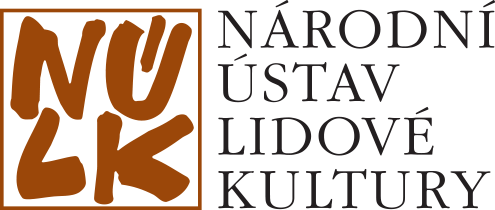“The mission of the open-air museums is to provide the wide spectrum of visitors with true stories about real people by means of life and interactive presentations using authentic buildings and constructions, and to encourage them to share their experiences with us or among them.“
The Czech Association of Open-Air Museums has its seat in the Wallachian Open-Air Museum in Rožnov pod Radhoštěm. The Association´s website presents interesting things and activities, as well as a map of open-air museums.
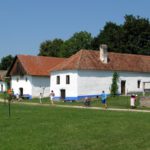
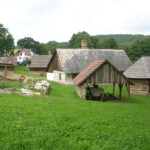
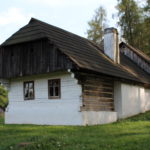
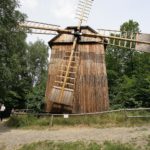
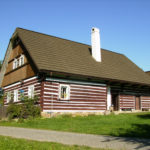
Central Bohemian Region
The Ethnographic Museum of the Slaný Area in Třebíz is a branch of the Regional Museum in Slaný. The museum pays attention to folk culture in the Slaný area situated in the western part of Central Bohemia. The museum does not include buildings rescued through their relocation, but in situ monuments, meaning the buildings that have survived at their original place. Only several buildings serve for the museum purposes, some others are still inhabited. The exhibitions in selected buildings inform the visitors about the way of life and habitation of local residents in the past. In 1995, the centre of the village was declared an urban conservation area.
The Ethnographic Open-Air Museum of the Elbe Region is situated in Přerov nad Labem and it is one of the oldest open-air museums in the Czech Republic. It is part of the District Museum of the Elbe Region in Poděbrady. It was opened to the public in 1967 as an open-air museum of vernacular architecture from the central Elbe region. Over time, the museum became home to more than thirty-one buildings and small constructions, such as old wooden beehives, a dovecote on pillar, a bell tower etc. Local cottages present traditional local farming, folk clothing, folk art and other peculiarities of the Elbe region. .
Zbečno, homestead no. 22, called Hamouz farm, is an ensemble of rural buildings that have survived at their original places and in a condition without significant adaptations. The building was opened to the public in 1995; it demonstrates period habitation, bread baking, folk handicrafts, and everyday habits, and gives an idea about daily life in a farmstead in the 19th century.
The Open-Air Museum of Folk Buildings in Kouřim is a branch of the Regional Museum in Kolín. The open-air museum was established in 1972, originally as a rescue open-air museum, whereby the first buildings were transferred from the Želivka river flood area (construction of a dam). Over time, the conception has changed, and these days it differs from conceptions implemented by other mostly regional open-air museums. The visitors can find rural buildings from the whole of Bohemia there, which, as original and reconstructed constructions or replicas, represent the basic regional types of vernacular architecture. Since 1995 the museum has offered programmes which try to explain traditional folk customs and habits to the wide public. In 1996, the precinct was declared a cultural monument of the Czech Republic.
Vysoký Chlumec Open-Air Museum. The Museum of Rural Buildings of the Central Vltava Region was established in 1998 as a regional rescue open-air museum with the District Museum in Příbram – Mining Museum being the founder of it. The natural precinct features farmsteads, peasant´s and smallholder´s cottages, farm buildings, water-powered technical constructions, and small sacral buildings, which mostly come from the 18th through early 19th centuries. The visitors can see nine constructions with five of them presenting interiors, or special and season exhibitions.
South-Bohemian Region
Bušek Tilt-Hammer is a functional technical monument from the 18th century. It is located about two kilometres south-west of Trhové Sviny. The present-day appearance of it is a result of a total reconstruction carried out between 1992 and 1995. The visitors have a unique opportunity to see the equipment in operation. The open-air museum also includes a unique collection of blacksmith´s tools and a collection of folk furniture from the Doudleby area with ceramics, reverse glass paintings, and furnishing from the turn of the 18th and 19th centuries.
Holašovice – a UNESCO Site. Although the village of Holašovice, situated close to the city of České Budějovice, is not a museum exhibition in the true sense of the word, it is our first and hitherto only ensemble inscribed on the prestigious UNESCO List of the World Cultural and Natural Heritage of Mankind, and to a certain degree it is a substitute for the absence of an open-air museum in the ethnographically rich region of southern Bohemia. The village of Holašovice represents an extraordinary compact safeguarded historical core of the village with regular mediaeval fundaments, which includes a large ensemble of bricked rural buildings. It is one of the best-surviving and most impressive evidences of the unique south-Bohemian architecture from the second half of the 19th century, as the fronts of all farmsteads were reconstructed in the style of “rural Baroque” between the years 1840 and 1880.
Plzeň Region
The Exhibition of Vernacular Architecture in Chanovice is part of the Dr. Hostaš Regional Museum in Klatovy. The museum employees and the volunteers from the museum club titled Vlastivědná společnost REGIO [REGIO – the Society for Local History and Geography] in Klatovy have built the exhibition since the 1990s. The open-air museum focusses on the rescue of rural buildings at risk of extinction in south-western Bohemia, their safeguarding and subsequent presentation to the wide public. In 2002, the first interior was opened to the public, and the visitors can currently see exteriors of ten sights.
Karlovy Vary Region
Doubrava Open-Air Museum is located in the village of Doubrava, which is administered by the Lipová municipality. In 1995, Doubrava was declared a rural conservation area. The Open-Air Museum of Vernacular Architecture includes an ensemble of typical buildings and constructions built in the style of Cheb vernacular architecture with the oldest compactly safeguarded farmyard with timbered buildings of the Cheb type from 1751. Interiors in particular buildings are equipped with farming tools and furniture from the 18th through 20th centuries.
Ústí nad Labem Region
The Ensemble of Vernacular Architecture in Zubrnice is one of the youngest and still extending open-air museums in the Czech Republic. It was opened to the public in 1987, and since 1997 it has been administered by the Heritage Institute. The precinct includes an old historical village, which is core of the museum and which is located among hills of the Central Bohemian Uplands. The visitors can see a diverse ensemble of log, timbered, and bricked houses whose interiors describe the life, work, and culture of original residents, who were predominantly Germans.
Stará Ves – an Open-Air Museum of Ore Mountains Village in Chomutov The ensemble of buildings in Stará Ves demonstrates the history and way of life of Ore Mountains residents. The buildings and their neighbourhood accommodate period items. The precinct is dominated by a functional Dutch-type wind mill. The log construction invites the visitors to see permanent exhibitions of handicrafts typical for the Ore Mountains, meaning production of wooden toys, lace making, beekeeping, and many others. The farmstead offers a complete view of the traditional life of a rural family and the common works in the farm and residential house. The local Ojcow birchs, which are among the most strictly protected plants, and the apple-tree orchard, which grew from grafts of old species collected in the already extinct villages in the region, are rarities. All the year round, the Stará Ves open-air museum offers events that demonstrate former way of life, customs of our ancestors, folk traditions, and skills of old craftsmen.
Liberec Region
Dlask Farm in Dolánky near Turnov is one of the most typical examples of several-storeyed log buildings typical for the Jizera River region. Originally a freeholder´s homestead built in 1716 and re-built several times later, is currently part of the Museum of the Bohemian Paradise in Turnov. The interiors present rural furnishing, and tools used for farming and handicrafts. The history of mills and miller´s trade in the Jizera River area enlivens the museum.
Pertoltice Open-Air Museum The Vernacular Buildings Association operates the open-air museum in Pertoltice near Frýdlant. The open-air museum was built around its core – the timbered (listed) house from the late 18th century and the smithy from the year 1893. The museum also offers a permanent exhibition and events demonstrating traditional customs and handicrafts – cooking in the open-hearth kitchen, bread baking, blacksmith´s work, and common activities related to the village life, as well as less known handicrafts, for example a more than 100-year-old family tradition in production and repairing the brass instruments. For those interested also other rare buildings in the village which are currently inhabited can be made accessible: a rural homestead with roof timbers and parts of the first floor from the mid-17th century, and a half-storeyed building with original roof timbers and constructional details from the second half of the 18th century.
Hradec Králové Region
TheOrlické Mountains Open-Air Museum in Krňovice is a unique example in the Hradec Králové Region, as this museum was founded and is operated by a private entity. Its objective is not only to rescue the vernacular sites at risk of extinction in the Hradec Králové Region, in the Orlické [Eagle] Mountains, and at the foothills of Krkonoše [Giant Mountains], but also to present the traditional way of life, farming, and handicrafts operated in the Orlické Mountains region to the public. The works on the project were ceremonially opened in the year 2002. The precinct is still under construction, whereby the visitors can enter selected buildings.
Pardubice Region
TheVysočina Ensemble of Folk Buildings
is the only open-air museum in the Pardubice Region and in eastern Bohemia in general. The items on display are in the settlement of Veselý Kopec in the village of Vysočina, in the settlement of Svobodné Hamry, and in the Betlém conservation area in Hlinsko.
Vysočina Region
The Michal Farm Museum in Pohleď. National Cultural Monument. Michal Farm is a rural open-air museum which allows its visitors to return to the life of rural people in the Habery domain in the period from the end of the Thirty Years´ War until the year 1848 when serfdom was abolished in the Czech lands.
South Moravian Region
The Open-Air Museum of Rural Architecture in South-East Moravia displays vernacular architecture of particular regions in the ethnographic area of Slovácko. The museum is divided into several precincts presenting the regions of Moravian Kopanice, Luhačovické Zálesí, and Horňácko, as well as technical water-powered constructions, viticulture, and meadow farming. Altogether sixty-four constructions are placed in the space that was shaped and planted with verdure to correspond to the original environment. The exhibitions in selected buildings acquaint the visitors with the way of life and habitation of people living both in mountainous regions of Slovácko, and in fruitful lowlands along the Morava River. The Open-Air Museum is operated by the National Institute of Folk Culture.
The Windmill in Kuželov is one of few surviving bricked windmills of “Dutch” type. It is said to have been built in the year 1842. In the 1940s, the mill came under the administration of the Technical Museum in Brno, which reconstructed it and put it into operation, however, as a museum exhibit. The adjacent farm and residential buildings accommodate an exhibition displaying habitation in the ethnographic area of Horňácko and agricultural tools used for traditional agricultural techniques.
Zlín Region
The Wallachian Open-Air Museum in Rožnov pod Radhoštěm The museum was founded by the Jaroněk brothers in 1925, and it is one of the oldest open-air museums in Central Europe. Its mission is to collect movable and immovable examples of traditional folk culture in the Trans-Carpathian region, where log houses occurred, and to take care of them, and to deal with research and scholar projects, publication activities, and presentation in the form of short-term and long-term (permanent) exhibitions. Currently, the museum owns about 126 thousand items in the collections. The permanent exhibitions are placed in fifteen farmyards and buildings in the Wallachian Village area, in five technical constructions in the Mill Valley, and in four special installations in the Timbered Town. The museum organizes a lot of events demonstrating traditional customs, handicrafts, and folklore performances, which comply with the founders´ idea to transform the open-air museum into a “living museum”.
The Ensemble of Folk Buildings in Topolná is managed by the Slovácko Museum in Uherské Hradiště. It includes two listed farmyards no. 90 and 93. The visitors can see examples of folk habitation, a smithy, and a fish farm. The ensemble is supplemented by small farm buildings, such as a fruit-drying kiln-house, a well, a smokehouse, a field cross etc.
Vernacular Architecture in Rymice. The conservation area with historical buildings that substantiate the vernacular architecture of eastern Haná is situated in Rymice near Holešov. The precincts is managed by the Museum of the Kroměříž Area and it is a unique ensemble of folk buildings which have survived in their original location and which have been adapted for museum purposes. In addition to the interiors equipped with authentic furniture, and tools used at home and in the fields, the visitors can see an old smithy with forgery and blacksmith´s tools, and a windmill of Dutch type situated in the nearby village of Bořenovice.
The Karlov Museum in Velké Karlovice is located in two buildings of a listed former merchant´s house from the early 19th century. The permanent exhibition shows how people lived in this part of Wallachia. The ethnographic collection is based on agricultural and shepherd´s tools, flax and wool processing, and sheep milk cheese production. Sets of woodcarvings present local folk art. The permanent exhibition presents the history of the production of pressed and blown glass in local glass factories.
The Open-Air Archaeological Museum in Modrá is located at the outskirt of the village of Modrá in the District of Uherské Hradiště. The museum presents the life of people living at the time of the Great Moravian Empire. The museum consists of a settlement with bulwark palisade, gate, and guard towers. Inside are placed replicas of the period buildings including semi-subterranean cottages, a craftsmen´s district, and a palace, meaning a house that was a seat of the local feudal lord.
Olomouc Region
The Ensemble of Vernacular Buildings in Příkazy (“Hanakian Open-Air Museum”) A part of the village of Příkazy, situated near Olomouc, is a renowned conservation area. The ensemble of safeguarded farmsteads with decorated arc entrances, and adjacent barns became the “Haná Open-Air Museum” in 1994. The core of the museum is Kameníček´s farmstead and four barns in the gardens located around the entrance building. The residential area accommodates many exhibitions devoted to folk handicrafts and traditional forms of housework (washing, ironing), while the exhibitions placed in the barns present diverse agricultural machines and tools.
Moravian-Silesian Region
